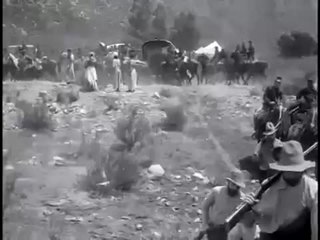Related Research Articles

The Musketeers of Pig Alley is a 1912 American short drama and a gangster film. It is directed by D. W. Griffith and written by Griffith and Anita Loos. It is also credited for its early use of follow focus, a fundamental tool in cinematography.

Sarah Blanche Sweet was an American silent film actress who began her career in the earliest days of the Hollywood motion picture film industry.

Judith of Bethulia (1914) is an American film starring Blanche Sweet and Henry B. Walthall, and produced and directed by D. W. Griffith, based on the play "Judith and the Holofernes" (1896) by Thomas Bailey Aldrich, which itself was an adaptation of the Book of Judith. The film was the first feature-length film made by pioneering film company Biograph, although the second that Biograph released.
Brute Force is a 1914 short silent drama film directed by D. W. Griffith, and starring Robert Harron and Mae Marsh. The film was shot in Chatsworth Park, Chatsworth, Los Angeles, California. It is a story of cavemen and dinosaurs, and perhaps the first live-action dinosaur film. It is a sequel to Griffith's earlier film, "Man's Genesis" (1912).

Friends is a 1912 film written and directed by D. W. Griffith and starring Mary Pickford, Henry B. Walthall, Lionel Barrymore, and Harry Carey. Walthall and Barrymore portray two old friends who each wind up involved with a beautiful girl (Pickford) who lives above a mining camp saloon.
At the Altar is a 1909 American silent drama film directed by D. W. Griffith. The film was shot in Fort Lee, New Jersey where early film studios in America's first motion picture industry were based at the beginning of the 20th century. A print of this film is in the film archive of the Library of Congress.

The Battle is a 1911 American war film directed by D. W. Griffith. The film was set during the American Civil War. It was shot in Fort Lee, New Jersey, where many early film studios in America's first motion picture industry were based at the beginning of the 20th century. Prints of the film survive in several film archives around the world including the Museum of Modern Art, UCLA Film and Television Archive, George Eastman House and the Filmoteca Española.
The One She Loved is a 1912 American silent drama film directed by D. W. Griffith. The film, by the Biograph Company, was shot in Fort Lee, New Jersey when many early film studios in America's first motion picture industry were based there at the beginning of the 20th century.

The Painted Lady is a 1912 American short drama film directed by D. W. Griffith and starring Blanche Sweet. A print of the film survives.

The Burglar's Dilemma is a 1912 American drama film directed by D. W. Griffith. A print of the film survives.
The God Within is a 1912 American short drama film directed by D. W. Griffith and starring Blanche Sweet. A print of the film survives.

Three Friends is a 1913 American short silent Western film directed by D. W. Griffith and starring Blanche Sweet.

A Chance Deception is a 1913 American drama film directed by D. W. Griffith and starring Blanche Sweet.
The Voice of the Child is a 1911 American drama film directed by D. W. Griffith and starring Blanche Sweet. The film was made by the American Mutoscope and Biograph Company when it and many other early film studios in America's first motion picture industry were based in Fort Lee, New Jersey at the beginning of the 20th century.
To Save Her Soul is a 1909 American short silent drama film directed by D. W. Griffith and starring Mary Pickford. The film was shot in Fort Lee, New Jersey when many of the early film studios in America's first motion picture industry were based there at the beginning of the 20th century.

Fighting Blood is a 1911 American short silent Western film directed by D. W. Griffith and starring George Nichols. It features Lionel Barrymore, Mae Marsh and Blanche Sweet. A print of the film survives in the film archive of George Eastman House Motion Picture Collection.

The Eternal Mother is a surviving 1912 American short silent drama film directed by D. W. Griffith and starring Blanche Sweet. The film was shot in Fort Lee, New Jersey when Biograph Company and other early film studios in America's first motion picture industry were based there at the beginning of the 20th century.
For His Son is a 1912 American short silent drama film directed by D. W. Griffith and starring Blanche Sweet. The film was shot in Fort Lee, New Jersey when Biograph Company and other early film studios in America's first motion picture industry were based there at the beginning of the 20th century. A print of the film survives today.
The Chief's Blanket is a 1912 American short silent Western film directed by D. W. Griffith, starring Blanche Sweet and Lionel Barrymore.

The Massacre is a 1912 American silent Western film directed by D. W. Griffith and released by Biograph Studios. It stars Blanche Sweet and Wilfred Lucas. The film was shot in 1912 and released in Europe that year, but not released in the United States until 1914.
References
- ↑ Koszarski, Richard (2004), Fort Lee: The Film Town, Rome, Italy: John Libbey Publishing -CIC srl, ISBN 0-86196-653-8
- ↑ "Studios and Films". Fort Lee Film Commission. Retrieved May 30, 2011.
- ↑ Fort Lee Film Commission (2006), Fort Lee Birthplace of the Motion Picture Industry, Arcadia Publishing, ISBN 0-7385-4501-5
- ↑ Amith, Deninis (January 1, 2011). "Before there was Hollywood there was Fort Lee, NJ". J!-ENT.
- ↑ "Silent Era: The Miser's Heart". silentera. Retrieved July 12, 2008.